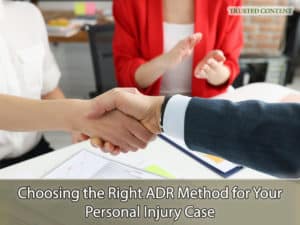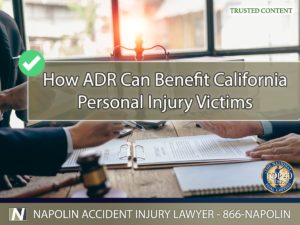How Alternative Dispute Resolution Can Benefit California Personal Injury Victims
The aftermath of personal injuries in California can be a complex and challenging journey for victims seeking justice and compensation. With the court system bogged down by delays and adversarial battles, alternative dispute resolution (ADR) emerges as a beacon of hope, offering a path to resolution that is often quicker, less stressful, and more flexible than traditional litigation.
The Basics of Personal Injury Law in California
California's personal injury laws are designed to protect individuals who have been injured due to someone else's negligence or wrongful actions. These laws cover a wide range of cases, including auto accidents, slip and fall incidents, and medical malpractice, providing a legal framework for victims to claim compensation for their losses and suffering.

What is Alternative Dispute Resolution (ADR)?
What is Alternative Dispute Resolution (ADR)?
ADR encompasses several processes and techniques outside of the court system, used to resolve disputes between parties. In the context of personal injury, the most common ADR methods are mediation, arbitration, and negotiation, each offering a unique approach to achieving settlement.
Mediation
Mediation is a collaborative process where a neutral third party, known as a mediator, facilitates discussion between the disputing parties to help them reach a mutually acceptable agreement. Unlike a judge or arbitrator, the mediator does not decide the case but instead assists the parties in understanding each other's viewpoints and working towards a resolution. Mediation is particularly valued for its ability to preserve relationships between parties who may need to continue interacting post-dispute, such as in cases involving family businesses or employment.
Arbitration
Arbitration involves a neutral third party, known as an arbitrator, who listens to both sides of the dispute and then makes a decision, similar to a judge in a court. Arbitration can be binding or non-binding, with binding arbitration decisions typically being final and enforceable by law. This process is appreciated for its speed and formality, offering a more structured approach than mediation while still being less cumbersome than traditional court proceedings. Arbitration is often chosen for its confidentiality and the ability to select an arbitrator with specific expertise relevant to the dispute.
Negotiation
Negotiation is the most informal method of ADR and involves direct discussion between the parties involved, sometimes with legal representation, to reach a settlement. It is the most flexible form of ADR, allowing parties to tailor the process to their needs and control the outcome directly. Negotiation can occur at any stage of a dispute and does not require a third-party facilitator, although lawyers often play a crucial role in advising their clients and structuring agreements. This method is particularly useful for parties seeking a quick, cost-effective resolution that addresses their specific interests and goals.
Advantages of ADR in Personal Injury Cases
ADR brings numerous benefits to the table, such as expedited resolution times that spare parties from the drawn-out timelines typical of court proceedings. It also promises a degree of privacy and confidentiality not available in open court, along with granting involved parties more control over the outcome and potentially reducing the overall costs of dispute resolution.
How ADR Works in Personal Injury Claims
Choosing ADR in a personal injury case begins with both parties agreeing to the process. This might involve selecting a mediator or arbitrator and deciding on the specifics of how the ADR process will unfold. Preparation includes gathering evidence, understanding the strengths and weaknesses of the case, and approaching negotiations with clear goals.

Choosing the Right ADR Method for Your Personal Injury Case
Choosing the Right ADR Method for Your Personal Injury Case
Deciding which ADR method to employ requires careful consideration of the specifics of the case at hand, the relationship between the parties, and the desired outcome. Each method has its merits and can significantly influence the direction and conclusion of the dispute resolution process. Feel free to consult with your personal injury lawyer, their experience in personal injury can help guide your decision.
The Role of Your Personal Injury Lawyer in ADR
An experienced personal injury lawyer plays a crucial role in navigating the ADR landscape, from selecting the most appropriate method for your case to preparing meticulously for sessions. Legal representation ensures that your interests are vigorously defended throughout the process.
Preparing for ADR: Tips for Injury Victims
Preparation is key to a successful ADR process. This includes organizing all pertinent documents and evidence, understanding the legal basis of your claim, and mentally preparing for the negotiation or mediation process. Effective preparation, guided by your attorney, lays the groundwork for a favorable outcome.

How Alternative Dispute Resolution Can Benefit California Personal Injury Victims
How Alternative Dispute Resolution Can Benefit California Personal Injury Victims
ADR presents a viable and often advantageous alternative to traditional court proceedings for personal injury victims in California. By choosing ADR, parties can benefit from a process that is typically faster, less costly, and more amicable. At Napolin Accident Injury Lawyer, we have a proven track record of effectively representing injury victims through ADR, ensuring their rights are protected and they receive the compensation they deserve. If you've been injured and are exploring your legal options, call us at (866)-NAPOLIN for a free consultation and discover how our extensive litigation experience can work in your favor.
- A Guide on Red Light Auto Accidents in California - August 14, 2024
- Self-Representing in a California Personal Injury Claim - August 13, 2024
- Common Sources of Distraction for Drivers in California - August 13, 2024
